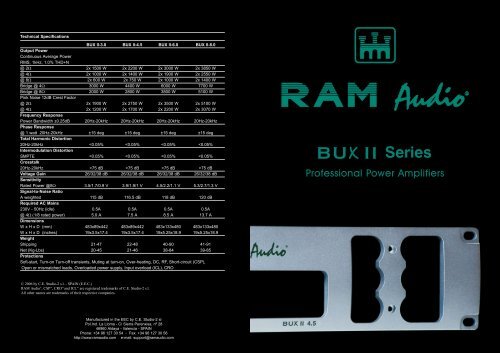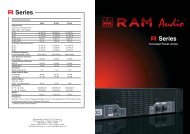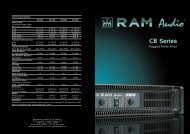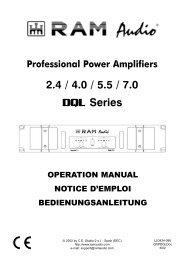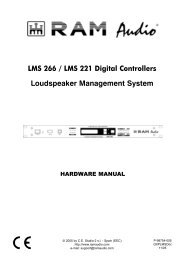BUX II Series catalogue - RAM Audio
BUX II Series catalogue - RAM Audio
BUX II Series catalogue - RAM Audio
Create successful ePaper yourself
Turn your PDF publications into a flip-book with our unique Google optimized e-Paper software.
Technical Specifications<br />
<strong>BUX</strong> <strong>II</strong>-3.0 <strong>BUX</strong> <strong>II</strong>-4.5 <strong>BUX</strong> <strong>II</strong>-6.0 <strong>BUX</strong> <strong>II</strong>-8.0<br />
Output Power<br />
Continuous Average Power<br />
RMS, 1kHz, 1.0% THD+N<br />
@ 2Ω 2x 1500 W 2x 2200 W 2x 3000 W 2x 3850 W<br />
@ 4Ω 2x 1000 W 2x 1400 W 2x 1900 W 2x 2550 W<br />
@ 8Ω 2x 600 W 2x 750 W 2x 1000 W 2x 1400 W<br />
Bridge @ 4Ω 3000 W 4400 W 6000 W 7700 W<br />
Bridge @ 8Ω<br />
Pink Noise 12dB Crest Factor<br />
2000 W 2800 W 3800 W 5100 W<br />
@ 2Ω 2x 1900 W 2x 2750 W 2x 3500 W 2x 5100 W<br />
@ 4Ω<br />
Frequency Response<br />
2x 1200 W 2x 1700 W 2x 2200 W 2x 3070 W<br />
Power Bandwidth ±0.25dB<br />
Phase Response<br />
20Hz-20kHz 20Hz-20kHz 20Hz-20kHz 20Hz-20kHz<br />
@ 1 watt 20Hz-20kHz<br />
Total Harmonic Distortion<br />
±15 deg ±15 deg ±15 deg ±15 deg<br />
20Hz-20kHz<br />
Intermodulation Distortion<br />
Power amplification at its best means absolutly linear handling of any complex audio signal.<br />
Our <strong>BUX</strong> <strong>II</strong> <strong>Series</strong> are unique, powerful amplifiers built to meet the highest professional<br />
requirements, thanks to new circuit philosophy that guarentees outstanding performance<br />
with field proven reliability.<br />
With these qualities, <strong>RAM</strong> <strong>Audio</strong> units outperform most modern amplifiers in terms of<br />
technical specs and pure sonic performance.<br />
To achieve industrial economy and<br />
efficiency, the <strong>BUX</strong> <strong>II</strong> <strong>Series</strong> Power Modules<br />
share component topology and maintain technical<br />
coherence by increasing heat sink size according to<br />
power output.<br />
<strong>BUX</strong> <strong>II</strong> <strong>Series</strong> have been designed giving extreme attention<br />
to all production steps from the engineering stand point.<br />
All boards are naturally<br />
double sided platethrough<br />
fiberglass. Most advanced<br />
SMT circuits are used for<br />
overall reliability, ease of<br />
assembly and full field<br />
servicing.
Features<br />
• 2/3U high, heavy duty steel chassis<br />
• Modular construction for easy servicing<br />
• Symmetrical layout for even weight distribution<br />
• High efficiency toroidal main transformer<br />
• Oversized, high energy, linear power supply<br />
• 2 and 3 steps, Class H <strong>Audio</strong> topology<br />
• Dual, Bridged or Parallel operation<br />
• Twin balanced inputs (Neutrik ® XLR connectors)<br />
• Dual Speakon and Binding posts outputs<br />
• 41 step detented input attenuators<br />
• High quality components used throughout<br />
• Dual, continuously variable speed axial fans<br />
• Efficient back to front cooling<br />
• Fault, signal, and clip indicators<br />
Protections<br />
• Duraluminium, 8 mm thick front-panel<br />
• Calibrated mains fuse<br />
• Unobtrusive carrying handles<br />
• Independent channel supply fuses<br />
• Selectable Gain: 26, 32 or 38 dB<br />
• Input signal muting at turn on<br />
• Continuous short-circuit protection (CSP )<br />
• Thermal overload protection<br />
• Inteligent clip-limiter (ICL )<br />
• Progressive Ramp input signal<br />
• Currentless Relay Operation (CRO )<br />
Recessed carrying handles<br />
<strong>BUX</strong> <strong>II</strong> <strong>Series</strong> Protection Systems<br />
I.C.L. - INTELLIGENT CLIP LIMITER:<br />
The <strong>RAM</strong> <strong>Audio</strong> ICL is an anticlip system that differentiates from conventional<br />
clip reduction systems in its dynamic tracking of the power supply rail values, to<br />
provide instant current/voltage demand and thereby eliminating any limiting of the<br />
signal dynamics. More like a valve amplifier, <strong>RAM</strong> <strong>Audio</strong>'s ICL system maintains<br />
sonic quality even when the amplifiers have exceeded the threshold of clipping,<br />
providing very high dynamics at negligible distortion levels.<br />
Commonly the anticlip systems limit the input signal matching it with to a fixed<br />
reference. The ICL system varies its threshold reference depending on the status<br />
of the output signal and the power supply rails. When the system detects the clipping<br />
status, it compares the above mentioned parameters, then changes the input<br />
signal amplitude to fit the signal between the supply levels, thus avoiding clipping.<br />
This change is made on the basis of two time constants, attack and release, this<br />
permits no dynamics loss in the first cycles and avoids the "pumping" effect.<br />
This system avoids effectively continuous clipping situations, even when an<br />
excessive signal is applied to the amplifier, and protects the speakers against the<br />
high frequency harmonics produced.<br />
C.S.P. - CONTINUOUS SHORT-CIRCUIT PROTECTION:<br />
Conventional short-circuit protection systems rely on simple output current limitation<br />
where excessive current through the output terminals continues to be conducted<br />
through the output devices, causing excessive stress. This may still lead<br />
to failure of the output transistors and associated circuitry, depending on the nature<br />
and duration of the short-circuit.<br />
Also, conventional current limiting systems find it hard to differentiate between<br />
a direct short-circuit across the speaker terminals and high current transients<br />
found in normal music operation. The CSP is a sophisticated protection system<br />
where the output current is continually monitored and set according to the load<br />
impedance, relative to zero ohms impedance. This allows dynamic performance<br />
at relatively higher current ratings in the case of music, but much lower current<br />
values in the case of a direct short-circuit or excessively low load impedance.<br />
At the onset of current limiting, the CSP circuit activates, opening the output<br />
relay which disconnects the excessive load. Every few seconds, the CSP monitors<br />
the short-circuit and maintains that situation if the short-circuit condition persists.<br />
This cycle repeats until the load returns to the correct value. The CSP<br />
system saves the output transistors from the high current stress of short-circuits,<br />
and in conjunction with the CRO system, protects the output relays and all the<br />
associated circuitry.<br />
This highly sophisticated current limiting system allows improved dynamic sonic<br />
performance at higher power levels, and at the same time, provides the amplifiers<br />
with a high degree of immunity against continuous short-circuits and mismatched<br />
loads.<br />
C.R.O. - CURRENTLESS RELAY OPERATION:<br />
The CRO is a system that protects the amplifier components<br />
and avoids transient situations at the speaker outputs when the<br />
output relay opens due to an abnormal event (high temperature,<br />
short-circuit, etc).<br />
In a conventional amplifier the relay operates with all the signal<br />
voltage between its contacts and has to interrupt all the<br />
current this voltage produces through the load. This type of<br />
operation reduces considerably the relay's life because of the<br />
electric arc generated between the contacts. This arc may<br />
damage the contacts permanently or at the least, increase the<br />
contact resistance, decreasing the damping factor dramatically.<br />
<strong>RAM</strong> <strong>Audio</strong> has developed the CRO protection system to<br />
avoid those dangerous situations. Basically, the CRO anticipates<br />
to the opening or closing of the output relay acting on the<br />
input signal, muting it, to permit the relay contacts to work<br />
always with zero current.


